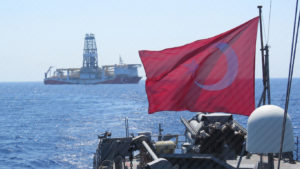The Turkish Navy in Context: Military Modernization and Geopolitical Transformation
Abstract: Amidst the Mediterranean turmoil, the Turkish Navy stands in the middle of current political-military affairs. In league with Turkey’s burgeoning technological and industrial defense base, the navy has been acquiring new capabilities. Furthermore, Turkey’s sea-power deterrent has been gaining a new geopolitical horizon through the widely-debated Blue Homeland concept. This brief focuses on the main pillars and trajectory of the Turkish Navy’s transformation through a strategic lens.
The Turkish Navy in Context: A Military Tour D’Horizon
As Turkey flexes its naval muscles more often in the Mediterranean, the Turkish Navy comes to the forefront with its active agenda. In parallel, the nation’s burgeoning defense industry is equipping all branches of the armed forces with indigenous weaponry, including Turkey’s sea-power deterrent.
This brief focuses on Turkey’s naval modernization projects and its geopolitical transformation around the Blue Homeland concept. The Turkish Navy is a highly-disciplined and well-trained branch with high combat-readiness capabilities. As portrayed in the Blue Homeland drills, the navy can operate simultaneously in the surrounding waters around Turkey.
The Turkish Navy has 16 pieces of frigates (Yavuz, Gabya, and Barbaros-classes) along with 4 pieces of MILGEM corvettes as the principal surface combatant deterrent. This posture is augmented by other various platforms. At the time of writing, a 12-piece attack submarine fleet forms the nation’s undersea deterrent. During 2020, six Reis-class (Type-214) submarine fleets will join the navy
Compared to Ankara’s geopolitical competitors, Turkey’s navy enjoys a clear numerical superiority in the Mediterranean. However, when it comes to the Black Sea naval balance of power, the Russian Navy’s ‘Kalibrization’ trends through Kalibr cruise missiles, as well as its illegal annexation of Crimea, remain balance-changers
At present, the Turkish Navy’s most noteworthy trend is its transformation from a coastal deterrent into a blue-water power projecting force. This transformation, in essence, does not derive from a doctrinal order of battle change. Rather, it manifests the incumbent Turkish political-military elites’ geopolitical worldview under the Mavi Vatan (Blue Homeland) concept.
Blue Homeland Geostrategic Concept and the Transformation of the Turkish Navy
Briefly, the Blue Homeland concept refers to extending Ankara’s political-military grip to the surrounding waters through advanced naval capabilities and with a pronounced geopolitics energy agenda. Turkey’s Oruç Reis seismic research vessel, for example, is actively accompanied by the navy during its Mediterranean missions.3 Even the Turkish Naval Institute’s (Milli Savunma Üniversitesi Deniz Harp Enstitüsü, succeeding the former naval academy) official periodical journal is named Mavi Vatan – the Blue Homeland. In many issues of the journal, Turkey’s young naval officers extensively write about issues like the importance of Libya for the Mediterranean maritime delineation, energy disputes and the role of gunboat diplomacy, and the Cyprus dispute.
Like every geostrategic concept, the Blue Homeland also has a threat perception. The sum of all fears, the nightmare of Turkey is to being caged into the rugged Anatolian Peninsula as an accidental land power with the very limited opening to the high-seas.
The Blue Homeland is centered on a trilateral geopolitical basis. First, at the very core of the geostrategic concept, there is a pronounced power projection calculus. Married to Turkey’s aspirant forward-basing posture, ranging from the Gulf to the Eastern Mediterranean and the horn of Africa, the Turkish elite strive to enhance the nation’s zone d’influence overseas. The second pillar remains an active gunboat diplomacy aspect which envisages a more active role for the Turkish Navy in energy geopolitics. The third and final pillar is a diligent effort for capability development through the nation’s burgeoning defense industry.
Naval power is everything to the Blue Homeland. To accomplish Ankara’s strategic endstate, the Turkish Navy is transforming into a blue-water actor with growing power projection capacity. As one would guess, Turkey’s mini-aircraft carrier aspirations, namely the amphibious assault ship project (TCG Anadolu based on the Spanish Juan Carlos I class LHD), remain the most crucial leap in this sense. Before the F-35 and S-400 conundrum,
the Erdogan administration hinted at the plans of procuring the F-35B,5 the short take-off and vertical landing (STOVL) variant of the Joint Strike Fighter noting that the Turkish Air Force was already set to acquire 100 conventional variants of the F-35 baseline.
Nevertheless, while the idea of operating a mini aircraft-carrier was tempting, carrier operations are complex. Above all, Ankara has to sustain rotation capability through at least two vessels of the kind if it does not want to fall into Russian or French predicaments with Admiral Kuznetsov and Charles de Gaulle carriers respectively. Second, an aircraft carrier, a mega-size or a mini one, has to have an embarked air-wing to offer state-of-the-art naval aviation capabilities. At present, the F-35B remains Ankara’s sole bet which is highly unlikely following the S-400 crisis. Third, power projection vessels demand state-of-the-art logistical infrastructure, and Turkey has had no experience in this class before.
As noted above, capability development efforts remain at the epicenter of the Blue Homeland. In this respect, apart from the mini-aircraft carrier ambitions, the Turkish Navy will be receiving high-end platforms through the 2020s.
The indigenous MILGEM corvettes make the crown jewels of Turkish ship-production capacity at present. The last ship of the first batch and the fourth ship of the class, TCG Kinaliada, was launched in 2017. The second batch of the vessels, probably with enhanced anti-air warfare capabilities and in a higher (frigate) class, will keep entering into service in the 2020s. In league with the Reis-class AIP submarines, the MILGEMclass principal surface combatants showcase the Turkish defense technological & industrial base. More than 50 Turkish companies’ contributions totaled 70% of the ships’ overall composition.
As noted, the Reis-class submarine project is noteworthy. With the new underwater boats, Turkey will, for the first time, enjoy air-independent propulsion submarines. More importantly, in the long-run, Turkish defense planners aim to turn the nation’s submarine fleet into a conventional strategic deterrent through the Gezgin sea-launched cruise missiles project. Even before the Gezgin entering into service, the Reis-class can gain land-attack capability through Harpoon Block-2 encapsulated missiles. Besides, with some 80% indigenous participation, the Reis-class will pave the ground for the next generation Milli Denizaltı (the national submarine) ambitions.7 Turkey’s indigenous Atmaca anti-ship cruise missiles will soon equip the navy’s surface vessels and ashore sites.8 The missile, with some 250km operational range, enjoys advanced guidance systems which make it a reliable stand-off weapon system.
Turkey’s potent amphibious units also deserve attention. Turkish military planners have started to establish amphibious capacity in the 1960s at the battalion–level amidst the escalating situation on the island of Cyprus. Before the 1974 military intervention, Ankara had generated an amphibious infantry regiment that took part in the campaign. Currently, the Turkish Navy has a brigade-level amphibious unit along with an elite marine commando (SAT & SAS) force. Detachments from the Marine Commando Brigade have fought in the nation’s counter-terrorism operations against the PKK for decades.
In recent years, Turkish military planners have deployed these battle-hardened units in demanding conflict zones, especially in Syria, to keep them combat-ready. The Turkish Navy’s special operations teams (SAS and SAT commandos) fought hard in the Syria campaigns. Besides, the Amphibious Marine Brigade’s detachments also fought in these endeavors. With TCG Anadolu entering into service, highly-likely as an amphibious assault vessel, Turkey’s abovementioned capacity will have additional importance.Lastly, Ufuk is another naval asset that deserves attention. Turkey’s first signal intelligence and electronic warfare vessel, TCG Ufuk, was launched in February 2019. During the launch ceremony, President Recep Tayyip Erdogan introduced the warship as the “eyes and ears of Turkey in the seas.
Dronization of the Turkish Navy
Turkey’s sea-power has been boosted through the country’s burgeoning dronization trends. At the time of writing, the Turkish Navy operates at least four ANKA-variant unmanned aerial systems. The drone comes with advanced sensors – synthetic aperture radar (SAR) / inverse synthetic aperture radar (ISAR) sensors and electro-optical / infra-red cameras – which offer very good intelligence and situational awareness capacity to any accompanying fleet. The Turkish Navy primarily uses its TUSAS-manufactured ANKA UAS (unmanned aerial systems) for intelligence, surveillance, target acquisition, and reconnaissance (ISTAR) tasks. To enable such a function, the latest Otomatik Tanımlama Sistemi (Automatic Identification System / AIS) features enable the UAVs to identify any surface vessels within hundreds of miles.11 The drone then shares its data with command & control hubs. The Turkish Navy also has Baykar’s combat-proven, ‘Pantsir-hunter’ Bayraktar TB-2 UAS in its arsenal. Together, Bayraktar TB-2 and ANKA constitute the Turkish Navy’s contemporary unmanned air-wing.

Turkey’s rising drone warfare capacity brings about aspects to the navy’s concepts too. Back in April 2018, for example, the Turkish Navy’s ANKA activity close to the island of Rhodes alarmed the Greek military and eventually led to the scramble of the F-16 fighter aircraft of the Greek Air Force.
The aforementioned dronization capacity will soon be augmented by a new system. TUSAS’ Aksungur, with sonobuoy pod and magnetic anomaly detector (MAD) boom payloads, are very critical and would make a critical anti-submarine warfare asset. Thus, with Aksungur, Turkey’s undersea warfare capabilities will have a robotic dimension too. From a military planning standpoint, delegating some of the anti-submarine warfare burdens to unmanned systems will lower operational costs and relieve maritime patrol aircraft and surface combatants, especially in high-risk areas.
Conclusion and Key Findings
Overall, Turkey enjoys a combat-capable, highly combat-ready naval deterrent with an ambitious military modernization agenda. The Turkish Navy is fast developing its arsenal with principal surface combatants, under-sea boats, power-projection assets, missile capabilities as well as dronization capacity. Together, this thorough capability development could prove to be very effective in the coming years and decades.
However, with the Turkish economy shrinking, defense economics remains the most serious obstacle before Ankara’s plans. Amidst the post-Coronavirus defense eco-system, many nations around the world had to scale-down their military modernization agendas.
The Blue Homeland geostrategic concept is the most important naval development in Turkish strategic affairs in the 21st century. Amidst the Mediterranean energy disputes, Turkey has relied on this concept with growing intensity. While the Blue Homeland aspiration paid-off in disrupting the rival camp, Turkey would still need a carefully customized diplomacy and alliance-building agenda to pursue its goals in the Mediterranean.

 Can Kasapoglu
Can Kasapoglu